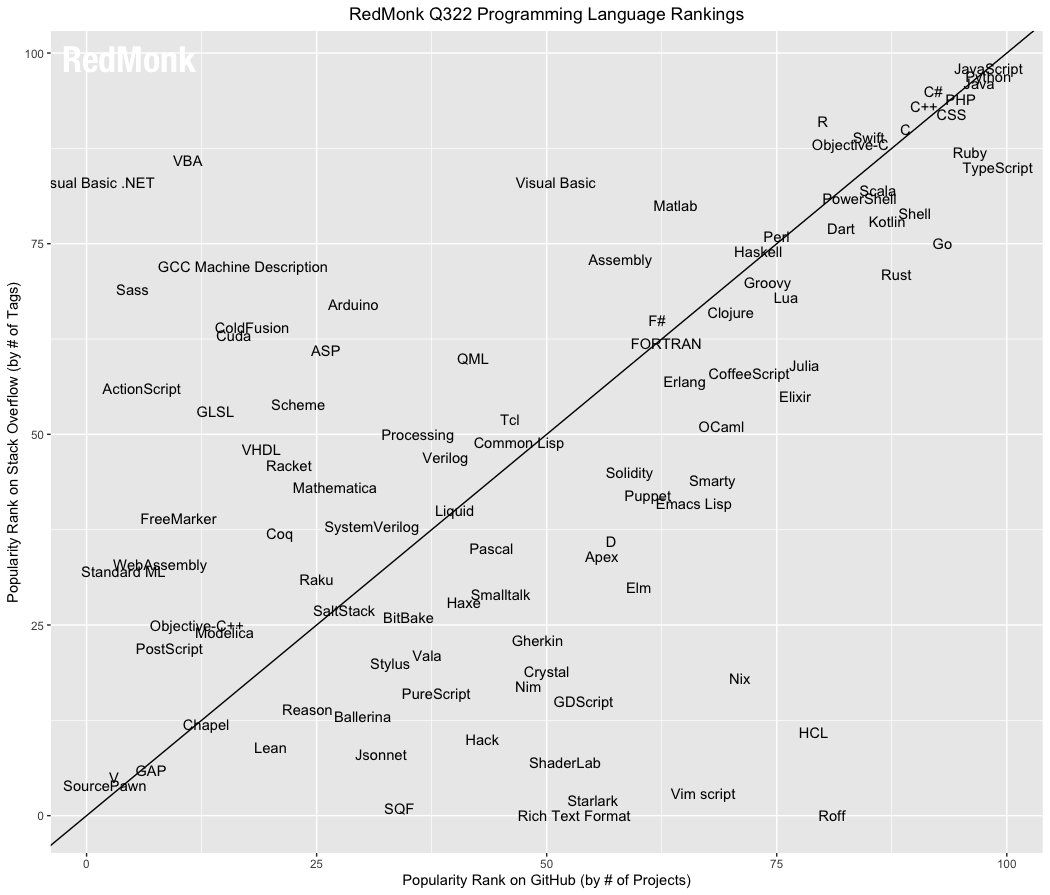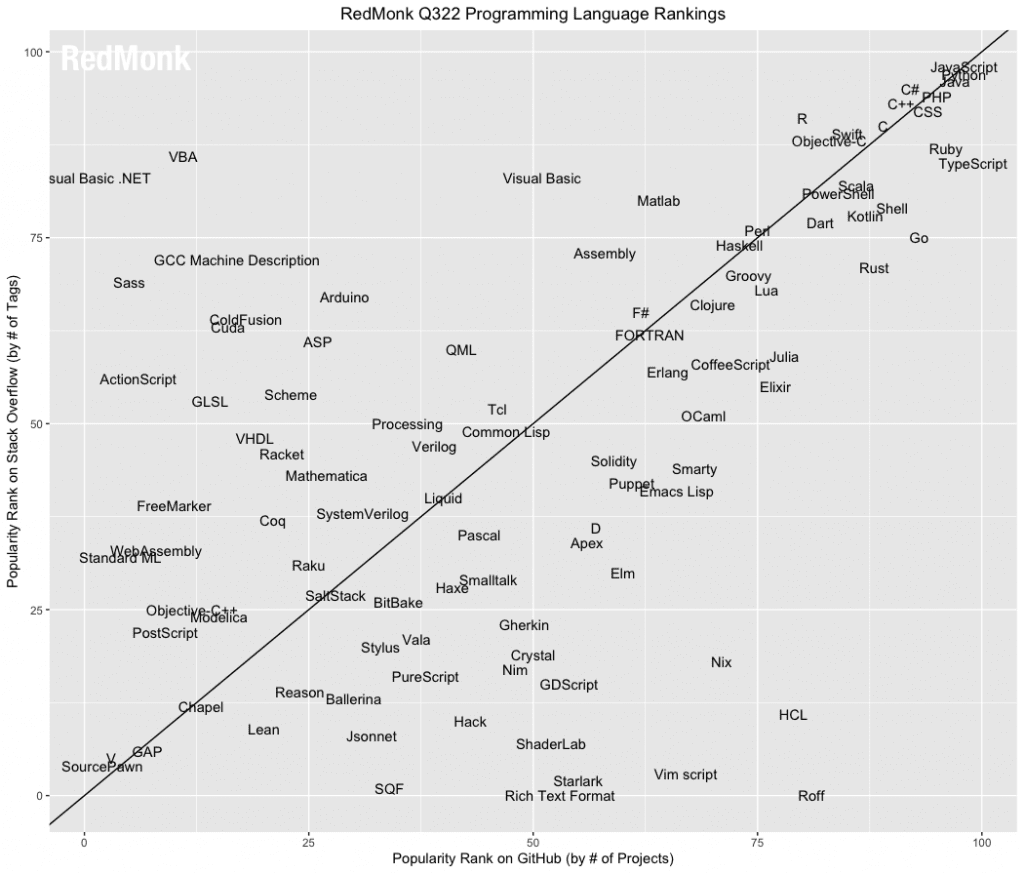Well-known software industry analysis company RedMonk released June 2022 (third quarter)Programming language leaderboard.
The RedMonk programming language leaderboard aims to gain insight into potential language adoption trends by tracking the code usage and the number of discussions about programming languages on GitHub and Stack Overflow, and sorting them after statistical analysis. The list is published twice a year, and this is the second list this year.Last list publishedIt was in March, the first quarter of programming language rankings.
At present, the basic idea of RedMonk’s sorting algorithm for programming languages has not changed, but the specific data collection method has changed.Now use GitHub Archive as a data source to analyze GitHub data; while the Stack Overflow section directly uses the utility data explorer provided by it, the specific sorting algorithmSee the official introduction.
The following figure is the programming language ranking of Q3:

The top 20 programming languages are:
1 JavaScript
2 Python
3 Java
4 PHP
5 C#
6 CSS
7 C++
7 TypeScript
9 Ruby
10C
11 Swift
12 R
12 Objective-C
14 Shell
15 Scala
15 Go
17 PowerShell
17 Kotlin
19 Rust
19 Dart
As always, there are fewer and fewer ranking changes in the list. According to RedMonk, as previously speculated, there appears to be a growing body of evidence that the assumption about a temporary balance in programming language usage is correct. The “emerging languages” on the list also have a certain age, such as Go, which has been released 13 years ago; Rust, 12 years; Dart and Kotlin, 11 years; TypeScript, 10 years; and even the relatively young Swift. It’s been out for eight years.
It is unreasonable to expect a new language to perform well in these rankings. They are incremental in nature and are more beneficial in terms of long-term use and discussion. But interestingly, we at RedMonk didn’t really encounter many emerging programming languages, with a few exceptions, such as Ballerina – 5 years old and ranked 87th.
Of course, this is not to say that the evolution of programming languages is or will be done. For better or worse, our industry is a capricious one committed to constant transformation. But it does show that, at the moment, industry innovation is concentrated in areas other than programming languages, and we may have reached a relative—possibly temporary—satisfaction with the variety of languages available to developers.
RedMonk analyzed and commented on the ranking changes of individual programming languages in this ranking:
- TypeScript (1):TypeScript has long been one of the fastest rising languages and one of the prime examples of why interoperability with popular existing languages can greatly facilitate usage and adoption. But recently, TypeScript’s ranking on this list has been stagnant. TypeScript has held the eighth spot over the past three survey rounds; this quarter it tied for seventh with C++. RedMonk has pointed to some general factors related to programming language popularity, including: the aforementioned interoperability with popular existing languages; availability of any added security-related features; and association with popular frameworks or projects. TypeScript is fortunate to have it all, “there is currently little indication that the language will go in any direction other than upward, the only real question is in what time frame”.
- Go(1):Unlike TypeScript, Go’s trajectory is not clear. After a steady and rapid growth phase, the language also appears to have stagnated, never surpassing No. 14 and dropping to No. 16 in the last three surveys. This quarter, however, Go moved up one spot, back to No. 15. On its own, this boost is of limited significance; the lower the rank, the smaller the difference. But before that, the Go language had not changed for more than a year. It also raises the question of whether it has room to rise further, or whether it will continue to hover in a position that is technically well-respected but not particularly under-the-radar.
- Kotlin (1) / Rust (0):Like Go, Kotlin has been in the same position in the past three surveys. It and Rust have kept pace in recent quarters, but Kotlin made the jump from 18 to 17 when Rust came in at No. 19 for the fourth time in a row. There were high hopes for the syntax-friendly language, as it could readily enter Java, one of the largest programming language ecosystems in the world, but maintaining its speed and upward momentum proved more difficult than expected. But maintaining its pace and upward momentum has proved more difficult than previously expected. Consider that Kotlin is now right behind Go. Watch the trajectories of the two languages over the next quarter or two to see if Kotlin will bring it closer, or surpass it in one fell swoop.
- Scala (-1):For the first time since 2020, Scala dropped from 14th to 15th on the list. While, as mentioned above, this is certainly not a major shift in fortunes, it does raise questions about the long-term future of language. Scala has been used as a highly trusted enterprise backend language for years, and little has changed in this regard recently. However, an interesting question is how to integrate Akka (a popular Scala framework)Change of licenseWhether and how it will affect Scala adoption. Scala is certainly broader than Akka, but if popular frameworks can accelerate adoption of the language they’re based on, isn’t it vice versa? The long-term impact of the re-licensing is unclear, but there are some known public instances, such as Flink saying it will not use the Akka version with the new license anymore. It’s certainly not possible to say that Scala will be like Akka, but in a stagnant and competitive language environment, it’s impossible to rule out the detrimental impact of this decision on the language.
- Objective C (1):Objective C has been on a significant downward trajectory since peaking at No. 9 in mid-2018. It has only risen once in the past seven surveys; but RedMonk sees the result as unsurprising and likely just a temporary blip in its gradual decline. The ancient language was first released in the same year as Ghostbusters (original), Raiders of the Lost Ark, and Temple of Doom, and its popularity in these rankings is largely due to its role as the iOS ecosystem Initially recognized as the language of choice, this is one of the largest and most commercially lucrative consumer markets in the world. But when Apple announced the Hyundai Swift as its successor in 2014, it all seemed like a foregone conclusion.
#RedMonk #ranking #TypeScript #tied #Kotlin #surpass #News Fast Delivery
